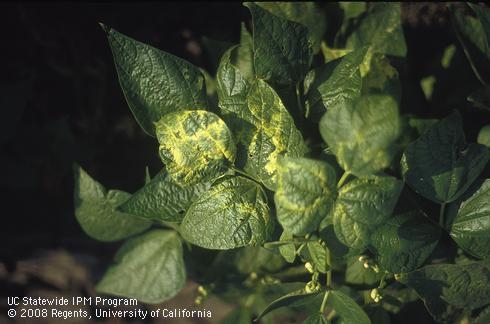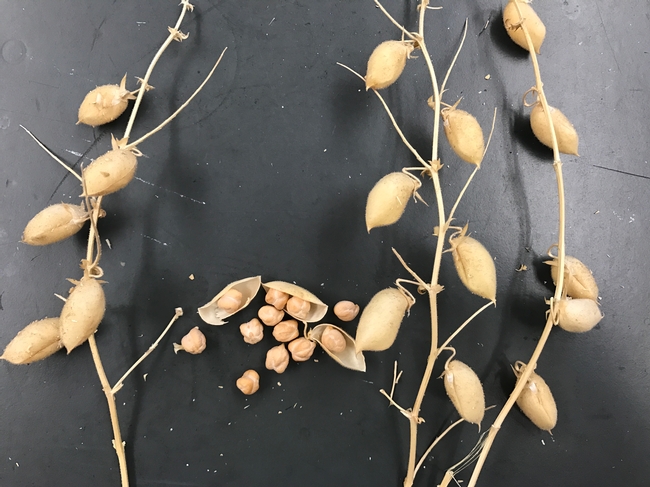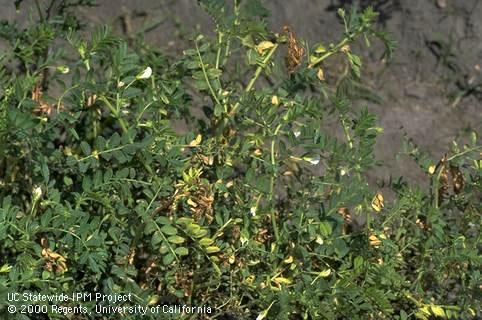- Author: Rachael Freeman Long
This spring, we found a garbanzo bean field in the Sacramento Valley with fusarium root rot, identified by our new UCCE Plant Pathologist, Cassandra Swett at UC Davis. Fusarium root rot, caused by the fungus, Fusarium solani f. sp. ciceris, attacks the underground stems and roots of plants. Early infection is characterized by elongated reddish streaks on the roots. As the disease progresses, these eventually form reddish-brown lesions that will surround the entire root, causing decay. The above ground plant symptoms of affected plants include yellowing, wilting, stunting, and dieback. This Fusarium root rot is very specific to garbanzos and field peas (it will not go to other field crops). Plants are more susceptible to this disease when they are stressed, such as under drought or water logging conditions. We suspect that our recent relatively warm, dry winter stressed the garbanzo plants in the affected field, favoring disease development that healthy plants would normally grow out of. Use of seed treatments will help manage this disease along with long-term crop rotation. More information on diseases in dry beans can be found on the newly revised UC IPM guidelines for dry beans.
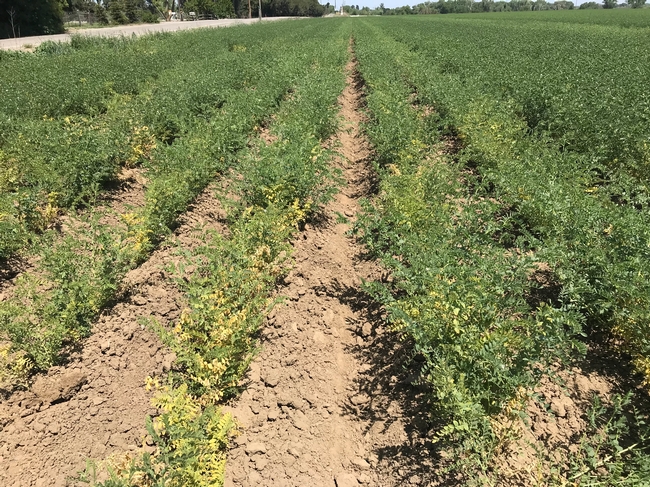
- Author: Rachael Freeman Long
The Diseases and Abiotic Disorders section of the UC IPM Pest Management Guidelines for Dry Beans have been recently revised and updated and are now available online at UC IPM Dry Beans Pest Management Guidelines.
Authors include Farm Advisors Carol Frate (emeritus) and Rachael Long and UC Davis Professor Paul Gepts. Two new diseases were added, including pythium in established plants and chocolate blotch on limas. The Fusarium wilt sections were also consolidated and new photos were added throughout the guidelines. This includes an updated photo page to compare common diseases and abiotic symptoms to help identify them (Photo Identification).
With the upcoming planting season for dry beans, these guidelines can help with managing diseases in your fields. Worried about southern blight? Yes, beans are susceptible and you'll need to rotate to a non-host crop, including corn or grains for at least 2-years to reduce the inoculum. How about alfalfa mosaic virus? This disease is transmitted by aphids from alfalfa fields, so avoid planting beans adjacent to alfalfa. This information and much more are available through the revised UC IPM Dry Bean guidelines!
The remaining pest management sections, including insect pest and weed management, are in the process of being revised and will be published soon!
- Author: Rachael Freeman Long
The UC Agriculture and Natural Resources Agricultural Issues Center (UC ANR) has released two new studies on the costs and returns of producing garbanzo beans (chickpeas), in the Sacramento and San Joaquin Valleys. Although acreage is relatively small (about 10,000 acres), garbanzos are an important crop because California growers produce the large, cream-colored seed for the canning industry. Canned garbanzos are often used for garnishes for salads.
The studies estimate the cost of producing garbanzo beans on 200 acres as part of a row crop rotation, using sub-surface drip irrigation. A 3-row bed tillage implement shallowly chisels, tills and re-shapes the beds, avoiding disturbance of the buried drip tape left in place. Planting of treated seed (for fungal and seedling diseases, Ascochyta rabiei, Rhizoctonia and Pythium), into residual soil moisture occurs in December. Seeding rates for the garbanzo beans are 85 pounds per acre.
Input and reviews were provided by UC ANR Cooperative Extension Farm Advisors and other agricultural associates. Current costs for the garbanzo bean crop were used, including material inputs, cash and non-cash overhead. A ranging analysis table shows profits over a range of prices and yields. Other tables show the monthly cash costs, the costs and returns per acre, hourly equipment costs, and the whole farm annual equipment, investment and business overhead costs.
The importance of these studies right now is that they are currently being used to help secure USDA crop insurance for garbanzo production, expected in 2020.
The new studies are titled: “Sample Costs to Produce Garbanzo Beans (Chickpeas), in the Sacramento and Northern San Joaquin Valleys – 2018”
“Sample Costs to Produce Garbanzo Beans (Chickpeas), in the Southern San Joaquin Valley – 2018
These studies and other sample cost of production studies for many commodities are available through UC ANR They can be downloaded from the UC Davis Department of Agricultural and Resource Economics website at http://coststudies.ucdavis.edu.
For additional information or an explanation of the calculations used in the studies, contact the Agricultural Issues Center at (530) 752-4651 or the local UCCE Farm Advisors; Sarah Light, selight@ucanr.edu, Rachael Long, rflong@ucanr.edu, Michelle Leinfelder-Miles, mmleinfeldermiles@ucanr.edu, or Nicholas E. Clark, neclark@ucanr.edu.
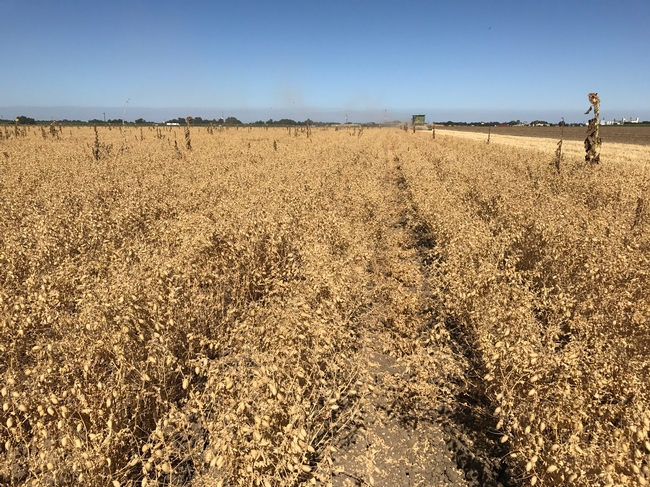
- Author: Rachael Freeman Long
- Author: Sarah Light
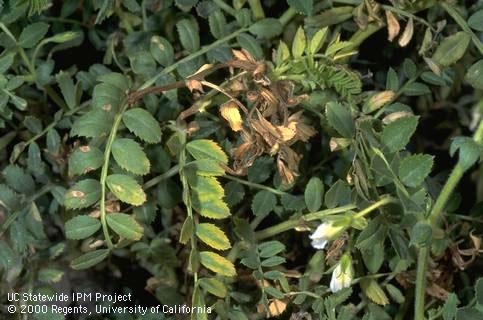
Ascochyta blight (Ascochyta rabiei, Didymella rabiei) was recently found in volunteer garbanzos in the Sacramento Valley, so keep an eye out for this disease in your production fields and be sure to control all volunteer garbs on your farm (yes, these volunteers are now long gone).
Symptoms
Ascochyta is a serious fungal disease of garbanzos that can kill seedlings and significantly reduce yields and seed quality in older infected plants. There are no other known crop or weed hosts. This disease is favored by cool, rainy weather and only infects the above ground parts of the plants. Early symptoms include circular light brown lesions on the plants that cause stems to weaken and break. Over time small, black, raised spots (pycnidia-like spores) will form concentric rings in the lesions. Developing seeds can become infected and, if used for seed, can lead to early infections in the next crop. The fungus survives outside or inside the seed.
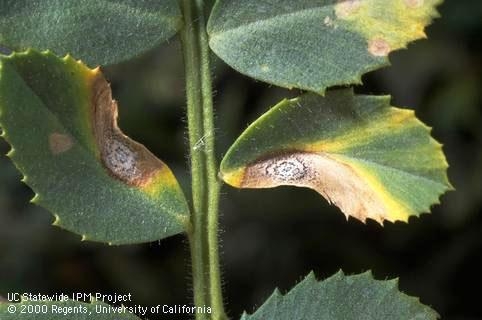
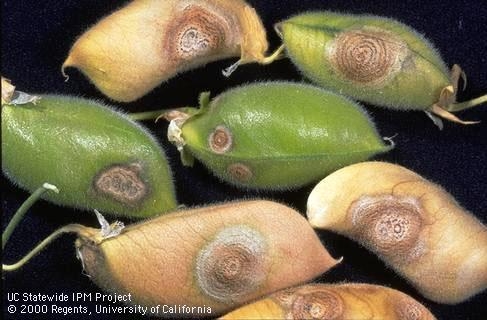
Comments
The fungus survives only on crop debris (and seed), not in soil. It does not produce resting spores to survive in soil. How long the debris can persist before decomposing depends on the climatic conditions. It lasts longer in drier conditions. During wet weather, spores are released and infect plants. Moderate temperatures (68º to 77ºF) and wet weather are optimal conditions for severe disease development.
Management
- Plant Ascochyta tolerant varieties.
- Keep stands healthy, as disease resistance can break down in stressed fields.
- Always use certified, disease free seed.
- Thoroughly incorporate infested garbanzo residue to hasten decomposition and to minimize the possibility of spore production and dissemination.
- Rotate to other crops for two or three years. That will eliminate inoculum in the soil because the fungus will not survive in the absence of a garbanzo host.
- Avoid early plantings (November and early December) since they result in large plants and a thick canopy, which provides ideal conditions conducive to disease development.
- Consider wide row and plant spacing. This increases ventilation between plants, reducing favorable conditions for plant infection.
- Use treated seed to avoid introducing the fungus to the field, such as Mertect 340-F, thiabendazole.
- Foliar applications of fungicides limit the rate of disease spread. Apply fungicides at first sign of disease and reapply according to the label if rainy weather is forecasted. Thorough coverage of the plant canopy is important. Options include Quadris (azoxystrobin), Endura (boscalid), or Headline (pyraclostrobin).
For more information, refer to the UC IPM website for dry beans or publication 8259, Ascochyta Blight of Garbanzos, by Frate et al. 2007.
- Author: Rachael Freeman Long
Join us for the UC Davis Dry Bean Field Day!
Thursday, September 7, 2017, 10 am- 12:15
UC Davis Agronomy Farm
Directions to farm: Take Hutchison Dr. approximately 1.5 miles west from Hwy 113, in Davis. Turn south on Hopkins Lane, and then take the first left turn (heading east) onto a gravel/broken pavement road with a row of olive trees; park along the fence. The field is located north of the Bee Biology Center. We will continue together UC Davis section 1 (near the beef and sheep barns) for a drone demonstration for the last part of field day.
Agenda
10:00–10:10 Sign in, Introductions, Updates, Rachael Long/Antonia Palkovic
10:10-10:30 Dry bean breeding program, Pest, Disease, and Drought Resistance: Paul Gepts
(Release updates: garbanzos, progress on lygus resistance in Lima bean)
10:30-10:45 Lima bean breeding update: bringing improved lygus resistance to large seeded bush varieties, improved surveying for lygus preferences (bug vac demo), searching for metabolomic and other markers for lygus resistance: Antonia Palkovic, Kimberly Gibson, and Stephanie Smolenski
10:45-11:00 MAGIC beans, tepary breeding, Canario and pink breeding selections, Antonia Palkovic and Paul Gepts on behalf of Jorge Berny
11:00-11:10 Determinacy introgression and Collaboration with Kirkhouse trust (breeding a better bean for Africa), Tamara Miller
11:10-11:25 Sources of drought resistance in Garbanzo bean, Kay Watt (how harvest index is obtained; plant yield partitioning)
11:20-11:35 Car caravan to section 1 to see Travis's plots.
11:35–12:00 Study of growth habit in MesoAmerican diversity panel, breeding a better growth habit for organics, continued heirloom variety trial with LFF, and using drones for high throughput phenotyping, Travis Parker
12:00-12:15 Discussion
Thanks to our generous Field Day and Bean Research sponsors:
California Dry Bean Advisory Board
UC ANR
UC Davis Plant Sciences
USDA: NIFA AFRI Plant Breeding
CONACYT, UCMEXUS
California Crop Improvement Association
Clif Bar Foundation
Lundberg Family Farms
Rio del Rey Farm
Kirkhouse Trust
USAID, RIFA
National Science Foundation

